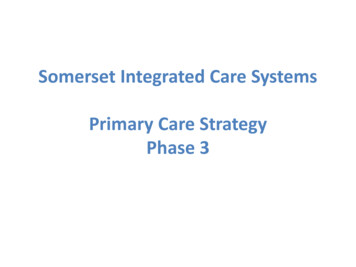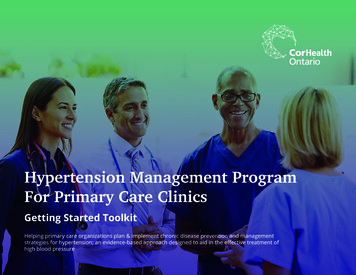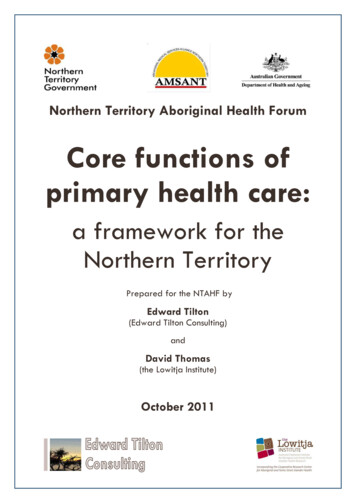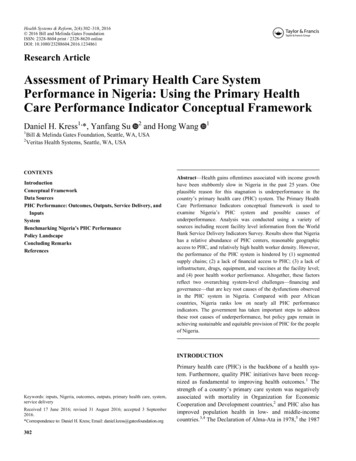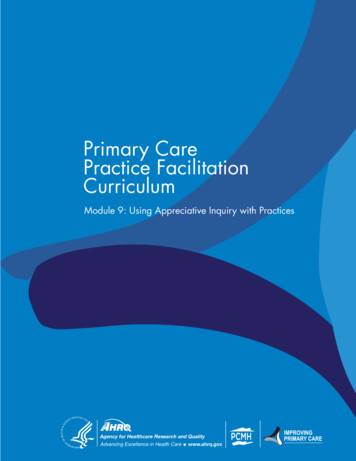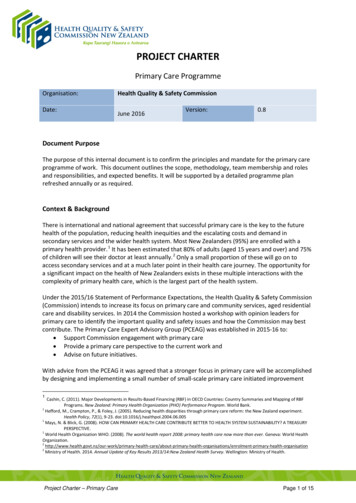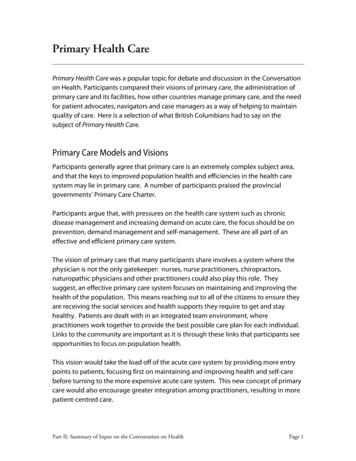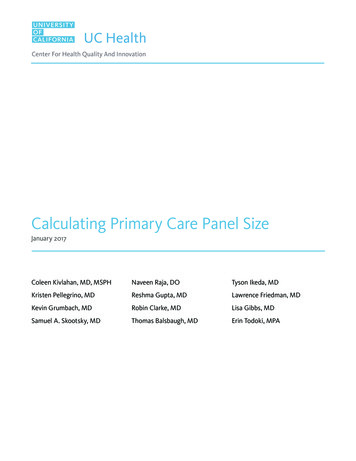
Transcription
Calculating Primary Care Panel SizeJanuary 2017Coleen Kivlahan, MD, MSPHNaveen Raja, DOTyson Ikeda, MDKristen Pellegrino, MDReshma Gupta, MDLawrence Friedman, MDKevin Grumbach, MDRobin Clarke, MDLisa Gibbs, MDSamuel A. Skootsky, MDThomas Balsbaugh, MDErin Todoki, MPA
Calculating Primary Care Panel SizeIntroductionIncreased demands for quality, population-based health care and advancements intechnology mandate that academic medical centers design their care in order tomeet these challenges as well as stay true to their three-part mission of clinical care,research and education.The University of California (UC) Center for Health Quality and Innovation (CHQI) wascreated in 2010 to promote, support, and nurture health care innovations at UC medical centercampuses. Specifically, the goals of CHQI are to support innovations that help achieve the TripleAim of Healthcare: to improve the patient experience, improve the health of the population,and reduce cost. CHQI has been successful in sharing best practices across the leadership ofUC Health at UC Davis, UC Irvine, UC Los Angeles, UC San Diego, and UC San Francisco, thenation’s largest statewide health sciences training program.In this collaboration, the primary care leadership of the five medical centerssought best practices to meet primary care access needs of the future. This paperaddresses the foundation of primary care: linking patients to a health care home, aprocess known as empanelment. Recognizing that new payment models incorporatepanel attribution as a way to measure access and the health of a defined population,the UC collaborative recognized that there was no national standard to guide theprocess of empaneling patients. The following questions guided the identificationof best practices:Question 1:How should patients be attributed to a primary care clinician’s panel?Question 2:What is the “right-sized” panel?Question 3:How can practice panels be adjusted for patient and population risk?Question 4:What are the best ways to right-size panels?2UC Center for Health Quality & Innovation/ UC Primary Care Collaborative – Calculating Primary Care Panel Size (January 2017)
BackgroundThe landscape of primary care in the U.S. has seen both growing demand for primary care access and increasedaccountability for population management, making determination of the “right sized” panel for primary care clinicians evermore important. A primary care panel refers to the number of patients cared for by a single clinician. The “right sized” panelis one that allows the clinician and associated care team to work to their fullest capacity, while meeting the population’sneeds for access, quality of care and patient experience. As the demands for primary care in the U.S. continue to climb, it iscritical for all primary care physicians to work to their full capacity. The Affordable Care Act (ACA) has benefited 20 millionof the 47 million uninsured Americans, providing improved access to primary care.1 In addition, primary care visits areexpected to increase by 15-25 million per year by 2019, primarily due to the aging population. 2,3As incentives in primary care shift from volume to value, it is critical for primary care physicians to understand thepopulation to whom they are accountable. Recent federal policies are designed to reward value and care coordination –rather than volume and care duplication, creating payment system changes to (1) increase accountability for both qualityand total cost of care and (2) develop a greater focus on population health management as opposed to payment for specificservices. 4 Primary care providers are in a strategically important position to meet these goals deploying a defined andachievable panel size.What is empanelment?Empanelment refers to the process of attributing individual patients to a clinician’s care team and is the first step ineffective population health management. Empanelment not only serves to determine accountability for population health,it is the basis of a therapeutic continuity relationship between a primary care clinician/team and patient. Empanelmentis one of the ten building blocks of primary care.5 Through a consistent relationship between the primary care team andpatient, benefits accrue to patient experience, provider satisfaction, clinical outcomes, and cost.6 Fortunately, technologyhas increased our ability to care for panels of patients, with electronic health records (EHR) able to identify a provider’spanel size and composition over time. Many primary care practices have grown due to expanded coverage, making itessential to determine the right sized panel, in which the demand for services are matched to the full capacity of the clinicalteam. The capacity of each clinician’s team is signified by panel size, recognizing variation in team composition (e.g. workdelegation) and in the patient population served. Efforts are then required to match demand with the supply, such that theactual panel size equates to the right-sized panel goal.What are the consequences when the actual panel size does not equal the right sized panel?Empanelment is an enabler of high-performing, high continuity primary care. However, a panel size that is too large or toosmall may result in problems in quality, access, clinician/patient satisfaction, and clinician burn out. A number of publishedstudies have shown correlations between panel size and quality. Larger panel sizes have been associated with poor diabetescontrol7 and decreased rates of cancer screening.8 Clinicians who are over-empaneled are likely to have difficulty providingaccess for established patients. Patients may have to wait weeks to months for an appointment, which increases the risk ofmissed appointments. The patients of these clinicians are likely to see other clinicians, reducing continuity and increasingcost. Over-empaneled clinicians are also at risk for burn-out due to increased work load of direct patient care, as well asadditional asynchronous work that is not generally recognized through traditional reimbursement. A recent study foundthat physicians spent 27% of their time on direct clinical face time with patients and 49% of their time on EHR and deskwork. While in the exam room, physicians spent 53% of the time on direct clinical face time, and 37% on EHR and deskwork. Over-empaneled clinician are at tremendous risk for excessive after-hours work in order to manage test results, refillsand asynchronous patient communication.9On the other side of the spectrum, while decreasing panel size can reduce burn-out10, a panel size that is too small mayindicate poor clinician engagement and care quality concerns, and create financial instability for the practice. Clinicianswho are under-empaneled are often seen by colleagues, or may see themselves as not fully contributing practice members.UC Center for Health Quality & Innovation/ UC Primary Care Collaborative – Calculating Primary Care Panel Size (January 2017)3
This can reduce engagement and physician retention. There are a variety of clinician-specific reasons for low panel size,such as clinical performance concerns, perceived low quality, poor communication skills, and limited clinician engagement.Alternatively, the under-empaneled clinician may have a higher than average patient annual visit rate because of clinician orpatient driven reasons such as highly complex adult patients or very young pediatric patients.Panel size also has significant implications for the primary care workforce shortage. One model identifies a shortage of33,000 primary care doctors in 2035.11 Decreasing panel size by 10% would result in an increased shortage to 60,000physicians. Increasing panel size by 10% decreased the shortage to 6,000. This highlights the dilemma of reducingpanel size. Smaller panel sizes may improve quality and reduce burnout, but may worsen access to primary care for thepopulation as a whole. In light of the increasing demands for primary care due to increased health care coverage andpopulation size, it is prudent to maintain access and value of care while utilizing our primary care workforce to its fullestcapacity through identification of the right-sized panel.QUESTION 1HOW SHOULD PATIENTS BE ATTRIBUTED TO A PRIMARY CARECLINICIAN’S PANEL?IntroductionThe concept of “empanelment” is a key conceptual framework for population health management. Particularly in thecontext of advanced primary care, empanelment assumes that the care of that panel is team-based, and built upon amedical home model. It is self-evident that any particular physician and health care team cannot endlessly expand theirpanel. Therefore, answering, “Who are our patients?” is fundamental to managing a population. The appropriate andprecise identification of patients truly affiliated with the practice is necessary to optimize the use of the team’s resourcesand provide effective care.Many primary care practices do not have a systematic way to identify the patients who should be considered for inclusionin their panel. Patients who are cared for through a capitation payment model are prospectively assigned to a primarycare provider (PCP). However in the fee for service (FFS) payment model, the patient is not formally tied to a PCP bya prospective payment. The FFS model thus demands a process for attribution so that the PCP and care team can beaccountable for the attributed patients and the total panel size can be identified. Often, the patients are attributed to aPCP based on the physician listed on the PCP banner in the EHR, which is often incorrect, outdated or lists a specialistas the PCP. In today’s PPO environment, many patients can receive care at multiple practices of their choosing; thus newattribution methods are needed to incorporate these complexities. Patients sort themselves according to their needsfor acute, emergent, preventive or chronic care, and may seek care at several sites that change as they age or developsignificant illnesses. Practices who are serious about managing a population’s health must have a large enough populationbase to scale resources and can no longer rely on only those patients who make frequent office visits. Practices strugglewith questions such as: are patients who make only one visit in three years part of the practice? Is that status reserved onlyfor those with chronic conditions who have many visits and non-visit contacts? The UC primary care collaborative proposesa step-wise approach to addressing who should be considered for inclusion in a panel, the process called “attribution.” Onlyafter developing clear approaches to this first step can other steps in empanelment be completed, the ultimate goal ofwhich is a right-sized panel size that is maintained by active management.4UC Center for Health Quality & Innovation/ UC Primary Care Collaborative – Calculating Primary Care Panel Size (January 2017)
Problem statementPatient attribution to clinical teams is the first step in patient empanelment, yet no consensus exists on how to attributepatients in fee-for-service payment models. Attribution involves two major steps: attribution of the patient to the practice,followed by attribution of the patient to a specific PCP. In order to operationalize attribution, several concepts must bedefined:1) the look back period2) the number and type of visits or contacts required to be “in the practice”3) the frequency of the attribution assignmentsFinally, clinicians must view the result as reasonable based upon their own knowledge of the patients in their practice.Conceptual approachClinicians may perform many types of services in multiple locations, both physical and virtual or asynchronous. Althoughalternative approaches to care provision are expected to grow over time, face-to-face encounters currently predominate.Attribution is how health insurance and other payers determine which PCP is responsible for a patient’s care whenprospective patient selection is not performed under a capitated payment model. Retrospective attribution is assessedbased on patient behavior and health care utilization occurring over a defined prior period. The goal of attribution is toaccurately reflect the correct patient-provider relationship.Many attribution models using various types of metrics have been described1. To some extent, the variations dependupon an accurate understanding of patients’ interactions with the entire health care system. A recent review identified84 sources describing 171 unique attribution models1. Health plans with access to complete claim datasets may be ableto attribute patients across health systems by various means such as visit or episodes of care history. Similarly, providergroups that accept patient assignment with a capitation model also may have complete datasets. Providers also havethe ability to include clinical data such as virtual or asynchronous interactions into attribution models.1 However, forpatients in fee for service systems allowing for freedom of choice, the provider will always have only partial information.Fundamentally though, primary care providers within a particular health system are primarily interested in which patientsshould have their focused resources. The selection of the attribution method should be calibrated to the intended purposeof the attribution--for the purposes of this paper, attribution is used as the first step in empanelment in ambulatory orhospital outpatient primary care practices.The look back period is the time period for evaluating utilization patterns for attribution purposes. There is no clearconsensus in the literature on the duration of the look back period. Indeed, the CMMI CPC and Safety-Net Medical HomeDemonstration Projects give only general guidance. 2,3 A short look back period ( 12 months) risks missing healthier patientswhose health care use is limited to preventive services, even though they may consider the subject practice their “usualsource of care.” If the period is too long ( 3 years), patients who have relocated or decided to seek care elsewhere may beincluded in the panel. Sources have used 18-36 months as an appropriate look back period. 2 The CMMI CPC and Safety-NetMedical Home Demonstration Project suggest that 24-36 months is appropriate. 2,3 Across the UC Health systems, lookback conventions vary between 18 and 36 months.There is somewhat greater consensus regarding the number of visits or contacts required to be included in a practice orclinician’s panel. In the CMMI CPC and Safety-Net Medical Home Demonstration Project two visits were specified, butother methods have used a single visit or contact.3There is no consensus about how often the attribution analysis should be reviewed. While daily analysis is possible, it is nota practical goal for most organizations. In the literature, active panel management is based upon monthly reports, thus amonthly update seems reasonable.3UC Center for Health Quality & Innovation/ UC Primary Care Collaborative – Calculating Primary Care Panel Size (January 2017)5
Finally, some patients will be prospectively assigned to practices or physicians by their health plan (e.g., under commercialor governmental capitation contracts). This population, which may have zero visits or contacts in a look back period despitebeing formally empaneled with the practice, also needs to be considered in panel size measurement, and thus in theattribution model.The Safety-Net Medical Home initiative outlined the “Four-Cut Methodology” for attribution to a specific PCP.31st cut: Patients who have seen only one provider in the past year. (Assigned to that sole provider).2nd cut: P atients who have seen multiple providers, but see one provider for the majority of services in thepast year. (Assigned to majority provider).3rd cut: P atients who have seen two or more providers equally in the past year (no majority provider can bedetermined). (Assigned to the provider who performed the last physical exam).4th cut: Patients who have seen multiple providers with no majority of visits with a single provider. (Assignedto last provider seen).UCLA’s attribution approach has similarities to the Four Cut Methodology and other sources4 , and has been informed byclinician feedback in a large multispecialty academic environment.Stepwise Approach for AttributionWe outline three steps:1. Define the overall primary care population base for all practices and all primary care providersA. 2 PCP in-person ambulatory office visits in the past 36 months defined by E&M codes 99201-99215, 99381-99397,or G0438/G0439; orB. 1 PCP in-person ambulatory office visit with preventive service E&M codes (99381-99397 or G0438/G0439)in past 1 year, andC. All health plan assigned (e.g. HMO) patients even if no visitsThis is a hybrid approach; the default is a 2-visit model with a three year look back with the purpose of capturing patientswho may visit infrequently and to exclude one-time visits that may not represent a relationship with the practice. Thisrule also recognizes that the use of the preventive services code or the annual Medicare Wellness code in a particular yearindicates that the provider is assuming a special role with that patient, even if there has been only a single visit. Urgent carecenter visits may count for one but not both of the inclusion visits.2. Assign patients from this population to specific active PCPsA. I f preventive service (99381-99397 or G0438/G0439) is present in the past 12 months, assign to the physician withthe most recent of these visitsB. U sing general E&M services (99201-99215), but excluding urgent care visits, assign to the physician with the mostvisits. If there is a tie, assign to the physician with the most recent visitC. Attribution of health plan assigned (e.g. HMO) population with no visits to the health plan assigned physician in thelook back period3. Run and disseminate analysis monthly6UC Center for Health Quality & Innovation/ UC Primary Care Collaborative – Calculating Primary Care Panel Size (January 2017)
Table 1. Attribution Model TradeoffsProsCons1. Reduces physician administrative burden1. Creates a source of truth outside of the workflow ofthe EHR.2. M irrors the visit method (E&M codes fromadministrative data) used by plans to define ACOpopulations (Medicare, Anthem and other commercialACO)2. Some loss of validity. There is some lag (esp. newpatients) due to billing cycle framework. But as visitstake place, eventually correct attribution will occurbut it is not real time.3. Overcomes the errors seen in EHR PCP field relatedto dynamic patient choices (changing PCP), specialistuse of field, and when PCPs leave practice.4. There is reliability. Attribution that “self –corrects”based upon patient visit behavior due to automatedanalysis of visit data. Does not require additionalwork by staff or physicians5. Physicians agree that the result is correctAn analysis of EHR accuracy at UCLA in 2015 demonstrated the following:A. 92.5% specificity for patients in attributed Primary Care Population being ‘active’ UCLA patientsB. The PCP field in the EHR did not accurately capture the attributed population in the panel1. About 20% of patients in the attributed Population have no PCP listed in the EHR2. About 13% of attributed patients have a specialist (non-PCP) listed in the PCP field3. About 2% of attributed patients have a PCP who has left UCLA in the PCP fieldAs the above data from UCLA demonstrates, maintaining the correct PCP linkage to the patient using the EHR PCP fieldmay be difficult. Maintaining the accuracy of the PCP field requires constant manual update activities by staff or clinicians.The UCLA automated attribution model is used to mitigate these problems likely to be prevalent in most health systemswith enterprise EHR systems.Environments with Resident Trainees as PCPsA modification of the above process is made when trainees have their own panels. Patients of resident trainee
Attribution is how health insurance and other payers determine which PCP is responsible for a patient’s care when prospective patient selection is not performed under a capitated payment model. Retrospective attribution is assessed based on patient behavior and health

